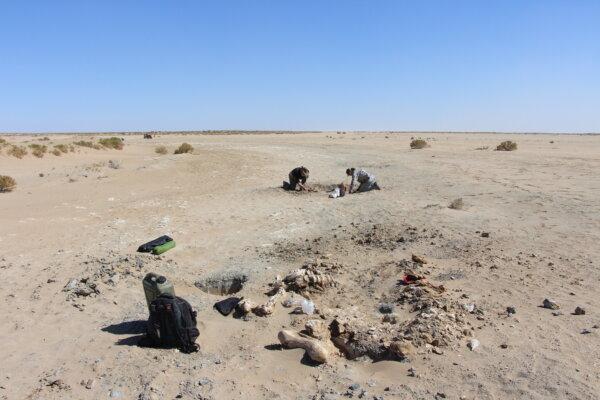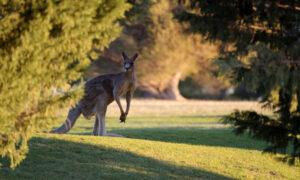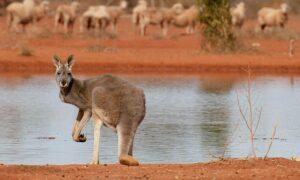Protemnodon Viator, which was also found in New Guinea, an animal said to weigh up to 170kg, making it the largest kangaroo ever discovered.
The discovery of complete skeletons from an ancient species of giant kangaroo has led researchers to uncover three unusual new species, with one weighing twice as much as a modern-day male red kangaroo.
A study, authored by palaeontologists from Flinders University, which looked at the extinct Protemnodon species, described how the animals, while closely related, had distinctive ways of hopping when compared to today’s kangaroos.
Protemnodon is a genus of extinct marsupials that lived in Australia during the Pleistocene epoch (about 2.5 million to 11,700 years ago). They are part of a group of marsupials known as the diprotodontids, which includes the well-known giant kangaroos and wallabies.
Protemnodon fossils, collected mainly intact from sites in Lake Callabonna in arid South Australia in 2013, 2018, and 2019, form the basis of the research conducted by Flinders University palaeontologist Isaac Kerr.
The Flinders research concluded the two of the ancient beasts would have looked similar to modern-day grey kangaroos, and weighed around 50 kilograms, although displaying a more squat and muscular appearance.
But the Protemnodon Viator, which was also found in New Guinea, is an animal said to weigh up to 170 kilograms, making it the largest kangaroo ever discovered and around twice as large as today’s ‘roos.
According to the Flinders report, the Viator, which in Latin means “traveller” or “wayfarer” was a long-limbed kangaroo that could hop fairly quickly and efficiently.
Protemnodon species were large and herbivorous, with some reaching sizes comparable to modern-day rhinoceroses.
These marsupials were adapted to a wide range of environments, from forests to grasslands, and their remains have been found in various parts of Australia.
They had robust skulls and strong jaws, indicating a diet of tough vegetation. The structure of their teeth suggests they were capable of grinding and processing coarse plant material.
One of the most famous Protemnodon species is “Protemnodon anak,” also known as the “giant wallaby.” This species was among the largest of the diprotodontids, with estimates suggesting it could weigh up to 130 kilograms (286 pounds).
Researchers believe they may have lived on the planet as early as five million years ago, while the last known species of Protemnodon disappeared around 40,000 years ago.
The extinction of Protemnodon and other large Australian marsupials is thought to have been driven by a combination of factors, including climate change and human activities, such as hunting and habitat destruction.

Other Species Had Different Characteristics
The study’s data was collected from museums across four countries. Mr. Kerr, detailing the laborious task, said he studied “just about every piece of Protemnodon there is.”
“We photographed and 3D-scanned over 800 specimens collected from all over Australia and New Guinea, taking measurements, comparing and describing them. It was quite the undertaking,” Mr. Kerr said.
“It feels so good to finally have it out in the world, after five years of research, 261 pages, and more than 100,000 words. I really hope that it helps more studies of Protemnodon happen, so we can find out more of what these kangaroos were doing.
“Living kangaroos are already such remarkable animals, so it’s amazing to think what these peculiar giant kangaroos could have been getting up to.”
In the 19th century, paleontologist Richard Owen classified six species of Protemnodon, just by working from teeth and without a complete skeleton.
Investigation by other scientists over the next century and a half refined the physiology of Protemnodon, and for many years they were all considered to be quadrupeda (use all four feet for walking and running).
But Mr. Kerr said the study of the South Australian skeletons contradicts this theory.
“Our study suggests that this is true of only three or four species of Protemnodon, which may have moved something like a quokka or potoroo—that is bounding on four legs at times, and hopping on two legs at others.
“The newly described Protemnodon mamkurra is likely one of these. A large but thick-boned and robust kangaroo, it was probably fairly slow-moving and inefficient. It may have hopped only rarely, perhaps only when startled.
The third new species, Protemnodon dawsonae, of which Mr. Kerr said less is known, was most likely a “mid-speed hopper, something like a swamp wallaby,” the study said.
Mr. Kerr emphasised how unusual it was for such closely related kangaroos to thrive in quite different environments, saying the different species of Protemnodon “are now known to have inhabited a broad range of habitats, from arid central Australia into the high-rainfall, forested mountains of Tasmania and New Guinea.”






















